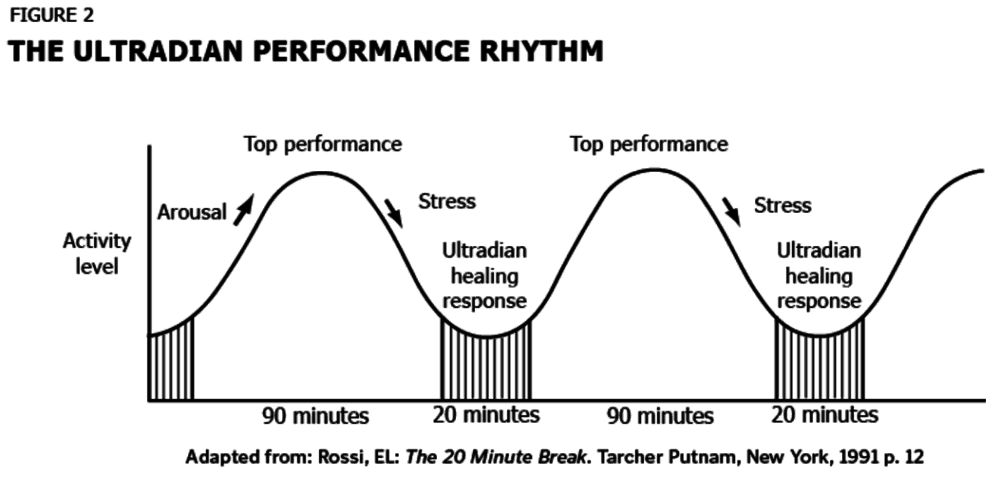Ultradian rhythm (lat. “ultra” – being outside, “dies” – day) is short-period rhythm or biological rhythm with periods shorter than a day (from minutes to 10-12 hours); in the spectrum, ultradian rhythms are located between physiological and circadian rhythms.
When it comes to the average workday, most of us simply try to power through from start to end. We sit down at our desks and get cracking, hopefully attacking our most difficult project first and avoiding the early morning email trap. When we’re finished with one thing, we move on to the next.
But what if I told you that this isn’t the most effective way to get things done? What if I told you that working this way actually puts you in competition with your own body and that strategic rest during the day is necessary for maximum productivity?
What exactly am I getting at? Ultradian rhythms.
This isn’t a particular hack or trick for focusing. It’s all about working in concert with your body’s natural rhythms to optimize your performance. If you know how to tap into your body’s ultradian rhythms, you can get more done by working when your body is at it’s best and then recharging when you need it most.
In this post, we’re going to break down the what, why, and how of ultradian rhythms so you know how to tap into this unique function of your body
The Science Behind Ultradian Rhythms
In the 1950s, sleep researcher Nathaniel Kleitman discovered that the human body tends to move through 90-120 minute cycles. At night, these cycles correspond to the different stages of sleep (alertness, light, REM, deep, etc.). During the day, these cycles correspond to different levels of energy and alertness.
Kleitman referred to these cycles as the “basic rest-activity cycle”. Since then, others have called these cycles ultradian rhythms.
In their book The Power of Full Engagement, Jim Loehr and Tony Schwartz say:
These ultradian rhythms help to account for the ebb and flow of our energy throughout the day. Physiological measures such as heart rate, hormonal levels, muscle tension and brain-wave activity all increase during the first part of the cycle—and so does alertness. After an hour or so, these measures start to decline. Somewhere between 90 and 120 minutes, the body begins to crave a period of rest and recovery.

While this may seem like a mere piece of science trivia, the implications for productivity are massive. Every 90-120 minutes, your body has a period of significant energy and alertness followed by a period of fatigue. During that burst of energy, you can work with your body to get far more done. During the low point of the cycle, you have to work against your body’s natural rhythms to accomplish much at all, which is often a losing battle.
Think about your own experience. How often have you hit a point in the afternoon when you’re physically incapable of getting more done? You’re most likely at a very low point in an ultradian cycle. Trying to break through that cycle and be productive is difficult and even counterproductive
Again, to quote Loehr and Schwartz:
We are capable of overriding these natural cycles, but only by summoning the fight-or-flight response and flooding our bodies with stress hormones that are designed to help us handle emergencies. The long-term cost is that toxins build up inside us. We can only push so hard for so long without breaking down and burning out.
The more you try to fight against your body, the less productive you’ll be and the more burned out you’ll become. Working in concert with your body, however, can unlock reservoirs of productivity you didn’t know you had.
Building Your Day Around Your Ultradian Rhythms
Researcher Anders Ericsson has studied high performers for many years, including athletes, musicians, chess players, and writers. In almost every arena, his findings have been the same: those at the top practice in very intense bursts.
While studying the best young violinists, Ericsson noted two very interesting items:
- They tended to work in 60-90 sessions.
- They often used naps to recover from the intense practice.
It turns out that intense bursts of work followed by periods of recovery are essential for maximum effectiveness and productivity.
The implications for the workday are clear. Instead of plowing through the day with your nose constantly to the grindstone, you’ll be more effective if you have periods of deep focus followed by short periods of total rest. You don’t need to be sleeping during those periods of rest, but your brain should be disconnected from work and able to recover.
Try This Routine
It’s relatively easy to implement this by using a routine like the following:
- Work on your most important task for between 60-90 minutes. Take your cues from your body. When you find your concentration and energy beginning to falter, it’s a good sign that you’re beginning to hit a low point in an ultradian rhythm.
- Break up those 60-90 minute periods using 30 minute Pomodoro sessions (25 minutes of focus, 5 minutes of rest).
- Take a full stop after 60-90 minutes. This break can last from anywhere between 20-30 minutes and could include taking a walk, meditating, a short nap, conversations with a friend, etc. Your goal is to let your brain turn off.
It’s crucial to ensure that you’re highly focused when you’re working and really resting when you’re on a break. If you don’t draw these hard and fast lines, you’ll end up wasting prime focus time and not letting your brain and body recover sufficiently during the downtime.
Simple Steps for Better Focus
Some simple ways to ensure high amounts of focus are:
- Put your phone in airplane mode.
- Shut down email, Slack, iMessage, and any other communication channels.
- Block social media sites.
- Listen to focus-enhancing music.
If you’re not intentional about scheduling your day around your ultradian rhythms, someone else will schedule your day for you, especially if you work in an office. Christopher Barnes helpfully notes:
Many employees are flooded with writing and responding to emails throughout their entire morning, which takes them up through lunch. They return from lunch having already used up most of their first peak in alertness, and then begin important tasks requiring deep cognitive processing just as they start to move toward the 3pm dip in alertness and energy.
The standard 8-5 work schedule was not designed with optimum productivity in mind. It was designed to keep employees in the workplace for a set period of time under the mistaken assumption that they would be working the entire time.
Whenever possible, don’t adhere to the standard practice of working straight from 8-5. Listen to your body. It may feel like a waste of time to take a break, but it’s not. In fact, it’s essential for operating at peak levels. Managing energy is the secret to maximum effectiveness.
Work Like The Hare, Not The Tortoise
For daily productivity, you have to do more than manage your time. You have to manage your energy level. Your body was designed to work in sprints followed by breaks, not constantly throughout the entire day. To be the most effective, it is best to work like the hare, not the tortoise.
Your energy level is directly related to your productivity. Your ultradian rhythms are your roadmap for doing your best work. Even if it seems counter-intuitive at first, you need to collaborate with your body by taking breaks. When you allow your body to recharge, not only will you have more endurance, but the quality of your “work time” will significantly improve. It is like putting gasoline in your car. If you do not stop to re-fuel, eventually you will run out of gas and stop being productive.
A coffee break is not a waste of time. In fact, it is an essential part of a productive day. Making time to recharge is not laziness. It is strategic. If your day includes the right balance of focused work and rejuvenating rest, you will multiply your productivity.
Key to Success (Next Steps)
Your key to success is to identify the times when you’re at your peak level of focus and productive energy. Leverage this time for focused work. Recognize the times when all you’re good for is Netflix. Double down on the peak times and then fully rest during the Netflix times.


0 Comments